Helicocranchia pfefferi
Banded piglet squid
Richard E. Young and Katharina M. Mangold (1922-2003)Introduction
The large number of undescribed species in the genus makes identification of any specimens difficult. Since the type locality of H. pefferi is in the North Atlantic, the North Pacific form of H. pfefferi described here may be one of these undescribed species.
Characteristics
- Arms
- Distal half of arms I and II in males with numerous sucker series (4 series in arms I, 8-9 in arms II.
- Suckers in middle of arms III not enlarged in females.
- Distal half of arms I and II in males with numerous sucker series (4 series in arms I, 8-9 in arms II.
- Head
- Beaks: Descriptions can be found here: Lower beak; upper beak.
- Beaks: Descriptions can be found here: Lower beak; upper beak.
- Mantle
- Papillae absent.
- Papillae absent.
- Pigmentation
- Orange/brown chromatophores form bands of sides of mantle.
- Orange/brown chromatophores form bands of sides of mantle.
Comments
More details of the description can be found here.Life History
Paralarvae are easily recognized as belonging to Helicocranchia by their shape and chromatophore patterns. In Hawaiian waters, however, there appears to be two different species in the genus. Two features, however, distinguish this paralarva from its less common congener (H. beebei?): The color pattern has more distinct bars and the eyes lack a long optic stalk (i.e., the optic lobe is adjacent to the central brain).

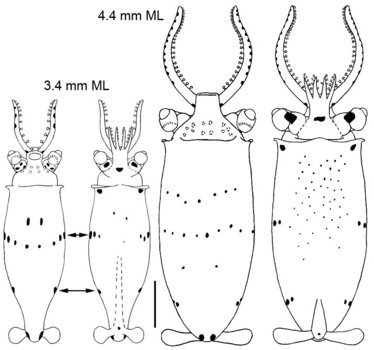
Figure. Ventral and dorsal views of paralarvae of H. pfefferi, Hawaiian waters. Left - 3.4 mm ML . Right - 4.4 mm ML. Arrows point to chromatophores that are part of prominent lateral bars. Ventral-head chromatophores hidden by the funnel are represented by dashed lines. The scale bar is 1 mm. Drawings by R. Young.
Distribution
Vertical distribution
Off California, captures made with open nets indicated an ontogenetic descent and no diel vertical migration. The majority of specimens over 40 mm ML were taken at depths of 400-600 m.
Geographical distribution
The type locality is the temperate North Atlantic, near Ireland (51°54'N, 11°57'W). Due to the large number of undescribed species in this genus, the distribution of H. pfefferi is uncertain.
References
Young, R. E. 1972. The systematics and areal distribution of pelagic cephalopods from the seas off Southern California. Smithson. Contr. Zool., 97: 1-159.
Young, R. E. 1978. Vertical distribution and photosensitive vesicles of pelagic cephalopods from Hawaiian waters. Fish. Bull., 76: 583-615.
Title Illustrations

| Scientific Name | Helicocranchia pfefferi |
|---|---|
| Location | off Southern California |
| View | lateral |
| Copyright | © 1996 Donald Bright |
| Scientific Name | Helicocranchia pfefferi |
|---|---|
| Location | Off Southern California |
| Reference | from Young, R. E. 1972. The systematics and areal distribution of pelagic cephalopods from the seas off Southern California. Smithson. Contr. Zool., 97: 1-159. |
| View | Ventral |
| Size | 41 mm ML |
| Image Use |
 This media file is licensed under the Creative Commons Attribution License - Version 3.0. This media file is licensed under the Creative Commons Attribution License - Version 3.0.
|
| Copyright |
©

|
About This Page

University of Hawaii, Honolulu, HI, USA
Katharina M. Mangold (1922-2003)

Laboratoire Arago, Banyuls-Sur-Mer, France
Page copyright © 2018 and Katharina M. Mangold (1922-2003)
 Page: Tree of Life
Helicocranchia pfefferi . Banded piglet squid.
Authored by
Richard E. Young and Katharina M. Mangold (1922-2003).
The TEXT of this page is licensed under the
Creative Commons Attribution-NonCommercial License - Version 3.0. Note that images and other media
featured on this page are each governed by their own license, and they may or may not be available
for reuse. Click on an image or a media link to access the media data window, which provides the
relevant licensing information. For the general terms and conditions of ToL material reuse and
redistribution, please see the Tree of Life Copyright
Policies.
Page: Tree of Life
Helicocranchia pfefferi . Banded piglet squid.
Authored by
Richard E. Young and Katharina M. Mangold (1922-2003).
The TEXT of this page is licensed under the
Creative Commons Attribution-NonCommercial License - Version 3.0. Note that images and other media
featured on this page are each governed by their own license, and they may or may not be available
for reuse. Click on an image or a media link to access the media data window, which provides the
relevant licensing information. For the general terms and conditions of ToL material reuse and
redistribution, please see the Tree of Life Copyright
Policies.
- Content changed 29 March 2018
Citing this page:
Young, Richard E. and Katharina M. Mangold (1922-2003). 2018. Helicocranchia pfefferi . Banded piglet squid. Version 29 March 2018 (under construction). http://tolweb.org/Helicocranchia_pfefferi/19580/2018.03.29 in The Tree of Life Web Project, http://tolweb.org/




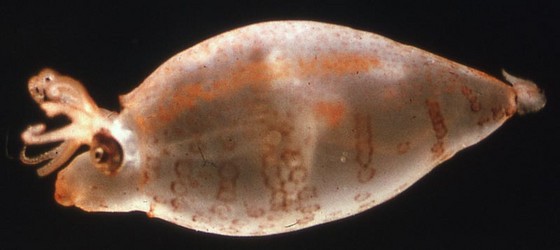
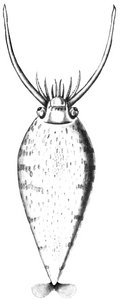
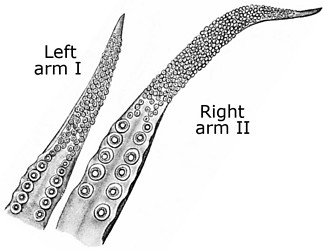


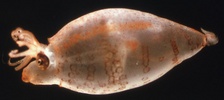



 Go to quick links
Go to quick search
Go to navigation for this section of the ToL site
Go to detailed links for the ToL site
Go to quick links
Go to quick search
Go to navigation for this section of the ToL site
Go to detailed links for the ToL site